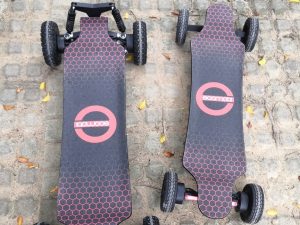Introduction
James was riding his electric skateboard along the bike path to work, as he did every day, when he was suddenly pulled over by a police officer. Though he had ridden the same route without incident for months, the officer cited James for illegally operating an unregistered motor vehicle on the path, fining him $200. James was shocked to learn electric skateboards occupied such a legal grey area, with regulations varying widely across states and even cities.
This type of scenario is increasingly common as electric skateboards skyrocket in popularity while laws scramble to keep up. With a compound annual growth rate (CAGR) of 8.14% from 2022 to 2028, the size of the worldwide electric skateboard market is expected to increase from USD 309.25 million in 2022 to USD 494.45 million. Riders praise them as affordable, sustainable transportation, but the motorized nature of the boards confuses their classification under state vehicle codes. Read on for a breakdown of the complex legal territory surrounding where and how you can ride electric skateboards across the United States.

Background on Electric Skateboards
E-skateboards operate via small in-wheel or belt-drive motors that propel a traditional skateboard deck at speeds averaging 15-25 mph. Riders control speed and direction via a handheld wireless remote that communicates with the board. Most models run off rechargeable lithium batteries, with ride times ranging from 5 to over 15 miles on a single charge. They also feature adjustable speed modes and regenerative braking ability.
Though rudimentary non-motorized boards first emerged in the 1950s as an offshoot of surfing culture, the first patented electric skateboard debuted in 1975, created by Nanjing-based inventor Lan Zhang using lead-acid batteries. Modern lithium battery advances later enabled the lighter, faster e-skateboard models currently dominating market sales.
Electric skateboards have become an increasingly popular mode of micro-mobility transportation and recreation across the United States in recent years. Though exact figures are difficult to ascertain, there is substantial growth in electric skateboard use on streets, college campuses, trails, and pedestrian spaces nationwide. The electric skateboard phenomenon reflects shifting attitudes toward mobility while inviting innovations in sustainability.
Laws and Regulations Surrounding Electric Skateboards
The laws governing electric skateboards are lagging well behind technological advancements, but as these boards become more popular, regulators will inevitably have to take action. In the US, electric skateboards are still illegal in most states. Still, there are a few legal locations in the US where you can ride an electric skateboard, including California, Michigan, Texas, etc.

The usage of e-boards is not restricted or allowed by any federal laws. This is not to say that people are free to do as they choose since there is no law; quite the contrary. Unfortunately, electric skateboards do not meet the minimal design standards required for any kind of vehicle to be allowed on the road.
Factors Influencing Legality
Local authorities grapple with appropriate classifications for electric skateboards as vehicles, bicycles, pedestrians or even toys. Their speeds exceed average pedestrian paces of 2-3 mph but e-boards offer none of the safety mechanisms considered standard equipment for motor vehicles.
Opponents argue that e-skateboards’ 15-25 mph speed capacities raise safety concerns regarding instability at high velocities, lack of rider protection elements and inability to brake rapidly compared to bikes or cars. Proponents counter that safety equipment like helmets, gloves and front/rear LED lights can sufficiently address these concerns.
Debates similarly rage around public rights of way. Supporters lobby for sidewalk and bike lane access since e-boards allow compact, sustainable mobility like bikes. But critics emphasize their motorized nature warrants similar restrictions as mopeds or motorcycles. Insurance liability requirements remain entirely unclear due to their classification status as neither toy nor vehicle.
State-by-State Breakdown of Laws
State-by-State Breakdown of Laws:
- California – Permitted under 500W power cap with under-18 helmet mandate
- Colorado – Permitted but DOT working on restrictions around 2020
- New York – Completely banned under state traffic codes
- Florida – Varies by the municipality, Orlando permits with restrictions
- Illinois – No state laws but Chicago completely prohibits the use
- Texas – No restrictions except under-18 helmet requirements
- Oregon – Permits electric skateboards under bike/pedestrian laws
- Ohio – No state-wide policy but Cleveland bans on public roads
- Massachusetts – Restricts riding speeds to 25mph
- Arizona – Leaves policy decisions to individual cities
- Georgia – Expressly prohibits on all public roads and sidewalks
- Hawaii – Permits slow models only, under 15mph speed

This breakdown shows how widely laws differ from state to state. Some states, like California, take a permissive stance, while New York bans electric skateboards entirely. Still, other states leave policy decisions in the hands of local city governments. So, individual research is crucial before riding in unfamiliar areas.
Outlook Ahead
As electric skateboards transition from novelty to mainstream mobility choice, usage conflicts will continue prompting legislation. Groups like the Electric Boarder Society lobby for expanded e-board access to bike lanes, paths and recreational areas. But others, like the Coalition for Micromobility Safety, push for tighter regulations around speed limits, licensing requirements and mandatory protective equipment.
Recent trends indicate state policies are likely shifting towards aligning electric scooters, skateboards, and bicycles under common codes as “micromobility” options. But inconsistencies will remain on municipal levels.
For now, e-skateboard operators must research regional ordinances thoroughly, take safety precautions and remain cautious when crossing jurisdictions with varying rules. But with projections expecting over 25 million electric skateboards traversing American sidewalks and roadways by 2030, changes to today’s fragmented legal landscape appear imminent.
Conclusion
Electric skateboards occupy an uncertain legal classification between pedestrian, toy vehicle and motorcycle. For users hoping to avoid hefty fines, familiarity with hyper-specific state law statutes and city ordinances remains crucial. Looking ahead, electric skateboard manufacturers will likely work closely with state and local officials to craft sensible mobility policies rather than outright bans. But until then, extreme caution riding electric skateboards is highly advised across unfamiliar areas.
Read More
- Beginners Electric Skateboards Guide – Ecomobl
- Electric Skateboard Motor Removal – Ecomobl
- Optimal Wheel Size Electric Skateboard – Ecomobl
- Expert Guide For Choosing An Electric Longboard Skateboard In 2023 – Ecomobl
- Electric Skateboard Tips Rough Terrain – Ecomobl




